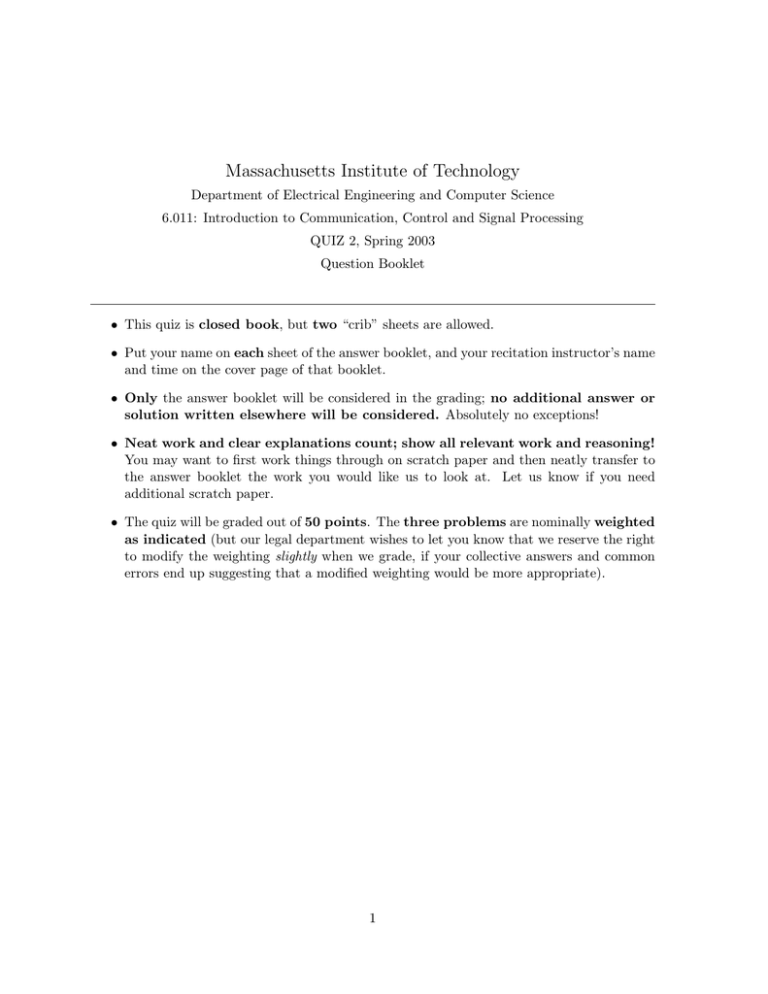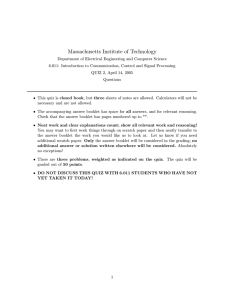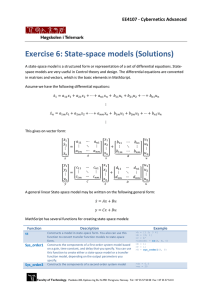Massachusetts Institute of Technology
advertisement

Massachusetts Institute of Technology Department of Electrical Engineering and Computer Science 6.011: Introduction to Communication, Control and Signal Processing QUIZ 2, Spring 2003 Question Booklet • This quiz is closed book, but two “crib” sheets are allowed. • Put your name on each sheet of the answer booklet, and your recitation instructor’s name and time on the cover page of that booklet. • Only the answer booklet will be considered in the grading; no additional answer or solution written elsewhere will be considered. Absolutely no exceptions! • Neat work and clear explanations count; show all relevant work and reasoning! You may want to first work things through on scratch paper and then neatly transfer to the answer booklet the work you would like us to look at. Let us know if you need additional scratch paper. • The quiz will be graded out of 50 points. The three problems are nominally weighted as indicated (but our legal department wishes to let you know that we reserve the right to modify the weighting slightly when we grade, if your collective answers and common errors end up suggesting that a modified weighting would be more appropriate). 1 6.011 Quiz 2, April 23, 2003 Problem 1 (36 points) x1 (t) ✲ System 1 y1 (t) = x2 (t)✲ System 2 ✲ y2 (t) (a) Suppose the transfer function of System 1 in the block diagram above is H1 (s) = s 1 = +1. s−1 s−1 (i) Find a first-order state-space model for System 1, using q1 (t) to denote its state variable, and arranging things such that y1 (t) = q1 (t) + x1 (t) . (ii) Is your state-space model for System 1: • reachable? • observable? • asymptotically stable? (b) Suppose System 2 in the block diagram above is described by the first-order state-space model q̇2 (t) = µq2 (t) + x2 (t) y2 (t) = 2q2 (t) where µ is a parameter, and we are given that µ = 1. (i) What is the transfer function H2 (s) of System 2? (ii) For what values of µ, if any, is the state-space model of System 2: • unreachable? • unobservable? • asymptotically stable? (c) (i) Combine the state-space models in (a) and (b) to obtain a second-order state-space model of the form y2 (t) = cT q(t) + dx1 (t) � � q1 (t) as the overall state for the overall system in the above block diagram, using q2 (t) vector q(t), and of course x1 (t) as the overall input, and y2 (t) as the overall output. q̇(t) = Aq(t) + bx1 (t) , 2 6.011 Quiz 2, April 23, 2003 (ii) Compute the transfer function H (s) from x1 (t) to y2 (t) using the model in (c)(i), and verify that it equals H1 (s)H2 (s). This is a little grungy, but important as a check on your answer in (c)(i). (iii) What are the eigenvalues of A in (c)(i)? Check that the eigenvalues you obtain are consistent with what you expect from your results in (c)(ii). What are the eigenvectors associated with these eigenvalues? There are values of µ for which one can find nonzero initial conditions q(0) such that the resulting zero-input solution q(t) (i.e., the solution with x1 (t) ≡ 0) decays to 0 as t → ∞. Find all such values of µ, and for each such µ specify all initial conditions that lead to such decaying zero-input solutions. (iv) For what values of µ, if any, is the overall system in (c)(ii): • unreachable? — which natural frequencies are unreachable? • unobservable? — which natural frequencies are unobservable? Interpret your results in terms of pole-zero cancellations in the block diagram on the previous page. (d) Suppose you can measure both state variables q1 (t) and q2 (t), so that you can choose x1 (t) = g1 q1 (t) + g2 q2 (t) . The resulting closed-loop system is evidently still described by a second-order LTI statespace model. What choice of g1 and g2 will result in the closed-loop natural (or characteristic) frequencies being at −1 ± j1? You can express your answer in term of µ. (If you’ve done things correctly, you will find that when µ = 2, for example, you get g1 = 0 and g2 = −5; and when µ = 1, you get g1 = 1 and g2 = −5.) Now determine for what values of µ, if any, your expressions for g1 and/or g2 have infinite magnitude, and reconcile your answer with what you found in (c)(iv). (e) Suppose you can only measure the input x1 (t) and the output y2 (t). Fully specify a scheme for estimating the state variables q1 (t) and q2 (t), in such a way that the error between each of the actual and estimated state variables can be expressed as a linear combination of two decaying exponential terms with time constants of 0.5 and 0.25 respectively. Will your estimation scheme work for all values of µ? Again, reconcile your answer with what you found in (c)(iv). 3 6.011 Quiz 2, April 23, 2003 Problem 2 (7 points) Consider a nonlinear time-invariant state-space model described in the form q̇1 (t) = q2 (t) q̇2 (t) = −βq13 (t) + x(t) , where β is some positive constant. (a) If the input x(t) is fixed at a constant positive value x > 0, determine the possible equilibrium values q 1 and q 2 of q1 (t) and q2 (t) respectively. (b) If the input actually deviates by a small amount x ˇ(t) = x(t)−x from its equilibrium value, and if the state variables correspondingly deviate by small amounts q̌1 (t) = q1 (t) − q 1 and q̌2 (t) = q2 (t) − q 2 respectively from their equilibrium values, find a linearized LTI statespace model that approximately describes how these small deviations are related to each other. In other words, find an LTI state-space model that has qˇ1 (t) and qˇ2 (t) as state variables, and x ˇ(t) as input. Is your linearized model asymptotically stable? [In deriving the linearized model, it may help you to recall that (1 + )3 ≈ 1 + 3 for || 1.] Problem 3 (7 points) Consider our standard system for DT processing of CT signals, where the C/D converter samples the continuous-time signal xc (t) with a sampling interval of T seconds, while the ideal D/C converter at the output produces a bandlimited interpolation of the samples y[n] using a reconstruction interval of T seconds. xc (t) ✲ C/D x[n] ✲ H(ejΩ ) ✻ y[n] ✲ D/C yc (t) ✲ ✻ T T Suppose the LTI discrete-time system between these two converters is a notch filter, i.e. has a frequency response H(ejΩ ) whose value is 0 at Ω = ±Ωo (where Ωo > 0 is termed the “notch frequency”) and whose value is nonzero everywhere else in the interval |Ω| < π. Suppose the input signal is of the form xc (t) = cos(ωin t + θ) . Determine ALL — and we mean all! — values of ωin for which the output yc (t) will be identically 0. 4


